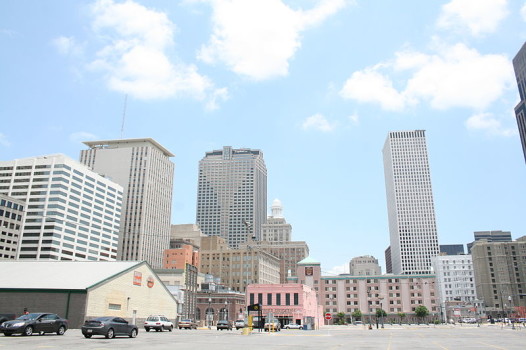Illustrator and writer Emma Fick is the published author of Snippets of Serbia. She is currently working on the illustrated book Snippets of New Orleans. To see more of Emma’s work and learn more about her, visit her website or find her on Instagram and Facebook.
In most cities, the word “downtown” is peppered with specificity. Most downtowns don’t have more than one name. Their history has and mostly likely always will be similar from beginning to end. Not to mention, the downtowns in other cities usually has strict boundaries (ah, those grid systems).
Well, like always, New Orleans isn’t like other cities, and it’s downtown – a.k.a. The Central Business District, a.k.a. The CBD, a.k.a The Art’s District, a.k.a. You get the Picture – is nuanced in a way the brightens the glitz of a typical “downtown.”
Let’s start with the history. The CBD didn’t start out with dollar signs paving the way for foot traffic. It was more about divisions than anything else. It goes like this. After the Louisiana Purchase in 1803, American residents settling in the city sought to establish neighborhoods and a culture distinct from those New Orleanians of European descent. The French Quarter and Jackson Square were basically the hub for Creole life. Just above Canal Street (one of the loose boundaries of the CBD) became known as “The American Sector.” Over the years the neighborhood established itself as the center for city business and visitors.
1803 doesn’t seem like far enough back, though. Let’s go back a bit further to make some further distinctions between this New Orleans downtown and other downtowns.
 Distinction #1-Always a plantation in this history: The CBD was once the plantation of Jean Baptiste LeMoyne de Bienville. Not many downtowns can say that.
Distinction #1-Always a plantation in this history: The CBD was once the plantation of Jean Baptiste LeMoyne de Bienville. Not many downtowns can say that.
Distinction #2-There were Jesuits and a king involved: The Jesuits purchased much of the land from Bienville over a period of years. The land was then sold at auction in 1763 after the King of France expelled the Jesuits from Louisiana. Jesuits and the King of France, we’re getting into even more distinct territory.
Distinction #3-It’s important to honor the dead: This land passed through many hands before it landed in the hands of Bertrand Gravier. He had a surveyor subdivide the plantation after the great 1788 fire in the French Quarter. He renamed the subdivision Faubourg St. Marie in memory of his deceased wife. This area (later called Faubourg St. Mary) extended from Common Street to near Howard Avenue and from Tchoupitoulas Street to Rampart Street.
And, then, we get to 1803.
Besides the history, the borders of the CBD are, at best, questionably defined. While other cities have definitive markers for their downtowns, the CBD is described as “falling roughly between Canal Street to Poydras and from Claiborne Avenue to about Tchoupitoulas Street.” Not exactly exact wording.
What is exact, though, is that the Superdome (housed in the CBD) is the world’s largest steel-constructed room unobstructed by posts. That’s right, it’s the winner of an award we wouldn’t possibly even think of could be won.
Now that’s a downtown.
 NOLAbeings Multimedia artist Claire Bangser created NOLAbeings as a portrait-based story project that marries...
NOLAbeings Multimedia artist Claire Bangser created NOLAbeings as a portrait-based story project that marries...  Voodoo in New Orleans: Reviving history: New Orleans fortune telling This article takes a deep dive into the history of Voodoo in New Orleans, its hybridization with Catholicism, and its present-day place in the city's culture. The author visits fortune-tellers in the French Quarter, using their guidance as a tool for introspection rather than a deterministic predictor of the future. Through her experiences in New Orleans, the author feels a mystical connection to both the past and the future.
Voodoo in New Orleans: Reviving history: New Orleans fortune telling This article takes a deep dive into the history of Voodoo in New Orleans, its hybridization with Catholicism, and its present-day place in the city's culture. The author visits fortune-tellers in the French Quarter, using their guidance as a tool for introspection rather than a deterministic predictor of the future. Through her experiences in New Orleans, the author feels a mystical connection to both the past and the future. 